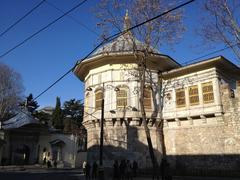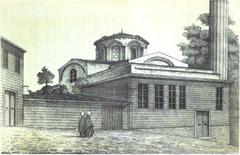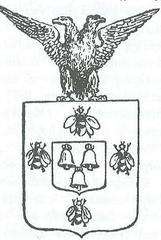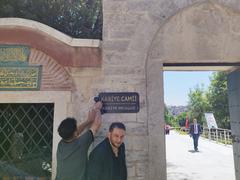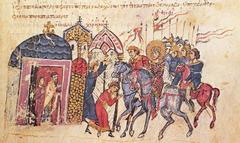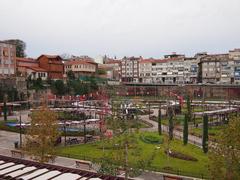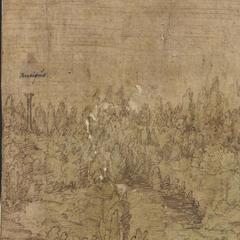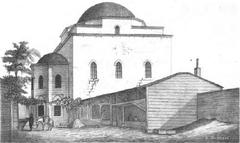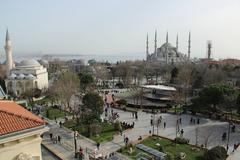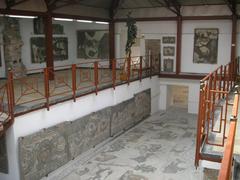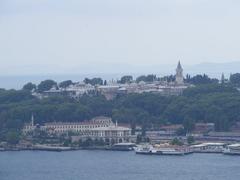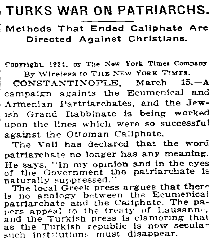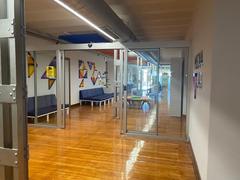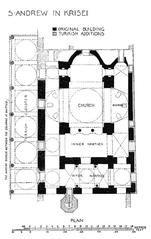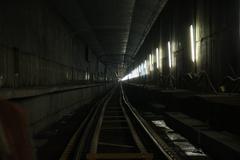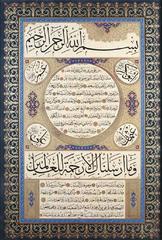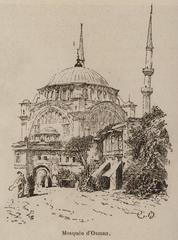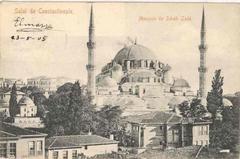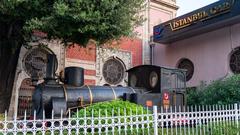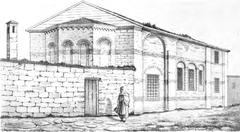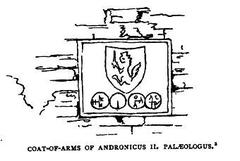Istanbul Railway Museum: Visiting Hours, Tickets, and Historical Highlights
Date: 03/07/2025
Introduction
Nestled within the historic Sirkeci Terminal in Istanbul’s Fatih district, the Istanbul Railway Museum (İstanbul Demiryolu Müzesi) invites visitors to discover Turkey’s rich railway history. Established in 2005 and operated by Turkish State Railways (TCDD), the museum not only preserves artifacts and narratives of the railways’ evolution from the Ottoman era to the modern Republic, but also offers a unique architectural and cultural experience. Housed in an evocative 19th-century train station designed by August Jasmund, the museum is a testament to Istanbul’s role as a bridge between Europe and Asia and a witness to technological, social, and cultural transformation (Wikipedia: Sirkeci railway station, Nomadic Niko, Atlas Obscura, TRT World).
This guide provides comprehensive information about visiting the museum, including opening hours, admission, exhibits, accessibility, and practical tips.
Table of Contents
- Introduction
- Origins of Railways in Istanbul and the Ottoman Empire
- Sirkeci Terminal: Architectural and Historical Significance
- The Golden Age of Rail Travel and the Orient Express
- The Establishment of the Istanbul Railway Museum
- Visiting the Museum: Hours, Tickets, and Accessibility
- The Museum’s Collection: Highlights
- Visual and Interactive Elements
- Cultural and Symbolic Importance
- Preservation and Public Engagement
- Recent Developments and Continuing Legacy
- Frequently Asked Questions (FAQs)
- Proximity to Other Historical Sites
- Practical Visitor Tips
- Conclusion and Call to Action
- References
Origins of Railways in Istanbul and the Ottoman Empire
The roots of the museum are intertwined with the advent of railways in the Ottoman Empire. After the Crimean War, the Ottoman state recognized the importance of railway connections to Europe. Early contracts in the 1850s and 1860s faltered, but in 1869, Baron Maurice de Hirsch was granted the concession to build the Rumelia Railroad, designed to link Istanbul with the European rail network via Edirne, Plovdiv, and Sarajevo (Wikipedia: Sirkeci railway station).
Construction from Istanbul to Halkalı began in 1870 and was completed in 1871. To better serve the city, the line was extended to Sirkeci in 1872, with a temporary station opening in 1873.
Sirkeci Terminal: Architectural and Historical Significance
The permanent Sirkeci Terminal, constructed under the direction of German architect August Jasmund, was inaugurated in 1890. The building is a striking example of late 19th-century architecture, blending European Orientalist and Ottoman styles. Its features include colorful stained glass, Oriental-Gothic façades, and modern amenities for its day, such as gas lighting and tile stoves (Atlas Obscura: Orient Express Museum at Sirkeci Terminal). The terminal quickly became a symbol of Istanbul’s cosmopolitan identity, especially as the eastern endpoint of the famed Orient Express.
The Golden Age of Rail Travel and the Orient Express
Sirkeci Terminal is forever associated with the romance of the Orient Express, which began service in 1883 and linked Paris to Istanbul. The train epitomized luxury travel and international intrigue, attracting diplomats, writers, and adventurers. The station’s platforms witnessed the comings and goings of figures who contributed to its aura. Artifacts from the Orient Express, including silver services and original plans, are preserved in the museum (Quick Guide Istanbul).
The Establishment of the Istanbul Railway Museum
Opened on September 23, 2005, the Istanbul Railway Museum was created to safeguard and display the heritage of Turkish and Ottoman railways as well as the unique history of Sirkeci Station (Sharing History: Istanbul Railway Museum). The museum occupies a 145-square-meter gallery within the terminal, showcasing approximately 300 artifacts, including documents, photographs, architectural drawings, tools, and Orient Express memorabilia (Tourism Caravan).
Visiting the Museum: Hours, Tickets, and Accessibility
- Visiting Hours: Open Tuesday through Sunday, 09:00–17:00. Closed on Mondays and public holidays.
- Admission: Free of charge; no tickets or pre-booking required.
- Accessibility: The museum is wheelchair accessible, with ramps and restrooms available.
- Guided Tours: Group tours may be arranged in advance through TCDD. Audio guides and brochures are available.
- Getting There: Located at Sirkeci Terminal in Fatih, easily reached by Marmaray line, T1 tram (Sirkeci stop), buses, and taxis.
The Museum’s Collection: Highlights
The museum offers a focused but rich array of railway artifacts and memorabilia:
- Orient Express Memorabilia: Original silver dining sets, personal items, and staff uniforms from the legendary train.
- Historic Photographs and Documents: Images and paperwork tracing the development of Turkey’s railway network and Sirkeci Terminal.
- Railway Equipment: Tools used by station staff and engineers, communication devices, and the driver’s cab of an electric train.
- Station Artifacts: The original station clock, bell, and vintage signage.
Most displays are labeled in Turkish, but some English translations and audioguides are available.
Visual and Interactive Elements
Sirkeci Terminal’s ornate architecture—with its stained glass, waiting halls, and Oriental-Gothic details—serves as a living exhibit. The museum encourages photography (without flash), and interactive elements such as model trains and signaling equipment provide an engaging experience. Virtual tours and multimedia content are available on select tourism websites.
Cultural and Symbolic Importance
Beyond its collection, the museum stands as a reminder of how railways shaped Istanbul’s growth, cultural identity, and international connections. Its context within Sirkeci Terminal, a site that once welcomed travelers from across Europe, enhances its historical resonance (Quick Guide Istanbul).
Preservation and Public Engagement
The museum plays a pivotal role in preserving railway heritage and fostering public appreciation for the technological and social impact of rail transport. Its central location and free admission make it accessible for both locals and tourists (Tourism Caravan). The proximity to major landmarks like Hagia Sophia and Topkapı Palace adds to its appeal (Daily Sabah: Fatih district).
Recent Developments and Continuing Legacy
Sirkeci’s above-ground platforms were reopened in 2024 as part of the T6 Sirkeci–Kazlıçeşme Tramway Line, ensuring the terminal remains a living part of Istanbul’s transport network (Wikipedia: Sirkeci railway station). The museum continues to adapt, serving as a thematic hub in the broader transformation of Istanbul’s historic stations into cultural centers (TRT World).
Frequently Asked Questions (FAQs)
Q: What are the Istanbul Railway Museum opening hours?
A: Tuesday to Sunday, 09:00–17:00. Closed Mondays and public holidays.
Q: Is there an admission fee?
A: No, admission is free for all visitors.
Q: Is the museum wheelchair accessible?
A: Yes, with ramps and accessible restrooms.
Q: Are guided tours available?
A: Group tours can be arranged in advance; audio guides are available on site.
Q: Can I take photographs?
A: Yes, photography is allowed without flash.
Proximity to Other Historical Sites
The museum is conveniently located near some of Istanbul’s most famous historical landmarks:
- Hagia Sophia and Topkapı Palace (10–15 minutes on foot)
- Spice Bazaar and Grand Bazaar
- Museum of Innocence and Istanbul Tünel
Practical Visitor Tips
- Best Time to Visit: Weekdays and early afternoons for a quieter experience.
- Facilities: No dedicated cloakroom or gift shop, but amenities like restrooms are available in the station.
- Language: Most labels are in Turkish; audioguide recommended for non-Turkish speakers.
- Safety: The Fatih district is generally safe; remain vigilant with personal belongings.
- Getting Around: Purchase an Istanbulkart for public transport.
Conclusion and Call to Action
The Istanbul Railway Museum offers an immersive journey through Turkey’s rail history within the architectural splendor of Sirkeci Terminal. Free admission, central location, and proximity to major attractions make it a perfect addition to your Istanbul itinerary. For a richer experience, consider combining your visit with nearby sites, and make use of audioguides and virtual resources. Stay updated on events and museum developments by following official channels and downloading the Audiala app for exclusive guides and travel tips.
